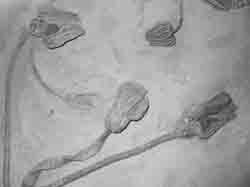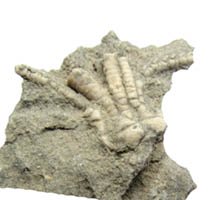Sign up for Lesson Plans, discounts & more!
Echinoderm Fossils
Echinoderms are a phylum of marine invertebrates that includes creatures such as starfish (or sea stars), sea urchins, sea cucumbers, brittle stars, and crinoids (also known as sea lilies). Many of these echinoderms are still living in modern-day seas. You can find them in tide pools and among the animals of a coral reef. All echinoderms, prehistoric or modern, are characterized by their radial symmetry. This means their bodies are organized around a central axis, and they typically have five-fold symmetry or five extensions like the five points of a star.
Echinoderms have a calcite skeleton made up of many individual plates or ossicles, which give them a rigid structure. They have a unique water vascular system which is a network of fluid-filled canals and tube feet. These special feet are used for movement, feeding, and respiration.
Echinoderms can be found in modern oceans worldwide, from shallow coastal waters to the deep sea. They play important ecological roles in marine ecosystems. Echinoderms are known for their remarkable ability to regenerate lost body parts, and they exhibit a variety of feeding strategies, from filter-feeding to predation, which means they eat other animals of the sea!

Facts about Echinoderm fossils:
1. Echinoderm fossils are commonly found in sedimentary rocks, particularly those formed in marine environments.
2. The oldest known echinoderm fossils date back to the early Cambrian period, over 540 million years ago.
3. Echinoderms have a relatively good fossil record because their hard, calcite skeletons have a higher likelihood of being preserved as fossils compared to soft-bodied organisms.
4. Fossil echinoderms come in a variety of forms, including star-shaped (asteroids), urchin-like (echinoids), and lily-like (crinoids).
5. Some of the most well-known echinoderm fossils are crinoids, also called sea lilies or feather stars. These creatures were abundant in ancient seas and their fossilized stalks and crowns are frequently found.
6. Echinoderms can be used as index fossils, meaning they can help geologists determine the age of rock layers. Certain species of echinoderms are known to have existed only during specific geological time periods.
7. Fossil echinoderms provide important information about the past environments and the ancient marine ecosystems they inhabited. For example, the presence of certain echinoderm fossils can indicate the presence of coral reefs or other types of shallow marine habitats.
8. Echinoderm fossils can vary greatly in size, from tiny ossicles (individual skeletal elements) to large, complete organisms like crinoid crowns or intact sea urchins.
9. Echinoderm fossils can sometimes preserve soft tissues like tube feet or oral tentacles, providing insights into the anatomy and biology of these ancient creatures.
10. The study of echinoderm fossils, known as paleoichnology, has contributed significantly to our understanding of the evolutionary history and diversity of this phylum, as well as their interactions with other organisms in ancient ecosystems.

Discover the Fascinating World of Echinoderm Fossils with Kids
Some of the most famous echinoderm fossils ever discovered are part of the "Burgess Shale." The Burgess Shale fossils are amazing! When they were first discovered it felt like finding buried treasure, but instead of gold and jewels, it's all about ancient sea creatures! This special geologic formation is in the Canadian province of British Columbia. These fossils were formed a really, really long time ago! We're talking about 505 million years ago! Can you even imagine that? The Burgess Shale holds a magical treasure trove of preserved fossils, including a bunch of echinoderms. Now, let's meet these superstar sea creatures!
Most common are the crinoids, also known as sea lilies. Crinoids looked like fancy flower people, standing on long tubes of tiny rings. You can find fossils of these crinoid tubes or “stems” easily in places where crinoids once lived. They make a great addition to any fossil collection. AND, if you’re lucky, your crinoid stem will have a tiny asterisk-shaped “hole” in the center. This long tube could fill with water and help with flotation.
Next come the starfish, famous for their star-shaped bodies and the sticky feet that are tiny suction cups. These echinoderms really live up to the meaning of their names. Not only are they shaped like a star, but their outer covering is coerced with tiny spines. Echinoderm literally means, “spiny” (echino) - skin (derm)!
The sea cucumbers, or holothurians, are like squishy worms of the sea. Almost miraculously, their soft bodies were preserved in the Burgess Shale along with their other echinoderm relatives.
The Burgess Shale fossils were a super lucky find. They have taught us so much about the evolution and diversity of echinoderms in the prehistoric oceans. We think prehistoric echinoderms were definitely some of the coolest underwater fossils to be found!
If you are interested in purchasing echinoderm fossils please visit our sister site.
Check out some of the Educational Materials for sale on our sister site fossilicious.com.

interested in more? If so, you may want to check out our other sites:
fossilicious.com - Our online fossil and mineral rock shop.
rocksandminerals4u.com - An educational site about rocks, minerals, and geology.
Geologic Time Geologic Time Line
Cenozoic Era
Quaternary
Neogene
Paleogene
Mesozoic Era
Cretaceous
Jurassic
Triassic
Paleozoic Era
Permian
Carboniferous
Devonian
Silurian
Ordovician
Cambrian
Archean Time
Hadean Time
Teachers Resources
Activities for Education and Fun
Earth Science Lesson Plans
Activities For Kids
Fossil Lesson Plans
Fossil Activities
Education Articles
Coloring Pages
Dinosaur Coloring Pages
Montessori Materials
Geology Club
Fossil Hunting
 |
 |
 |




